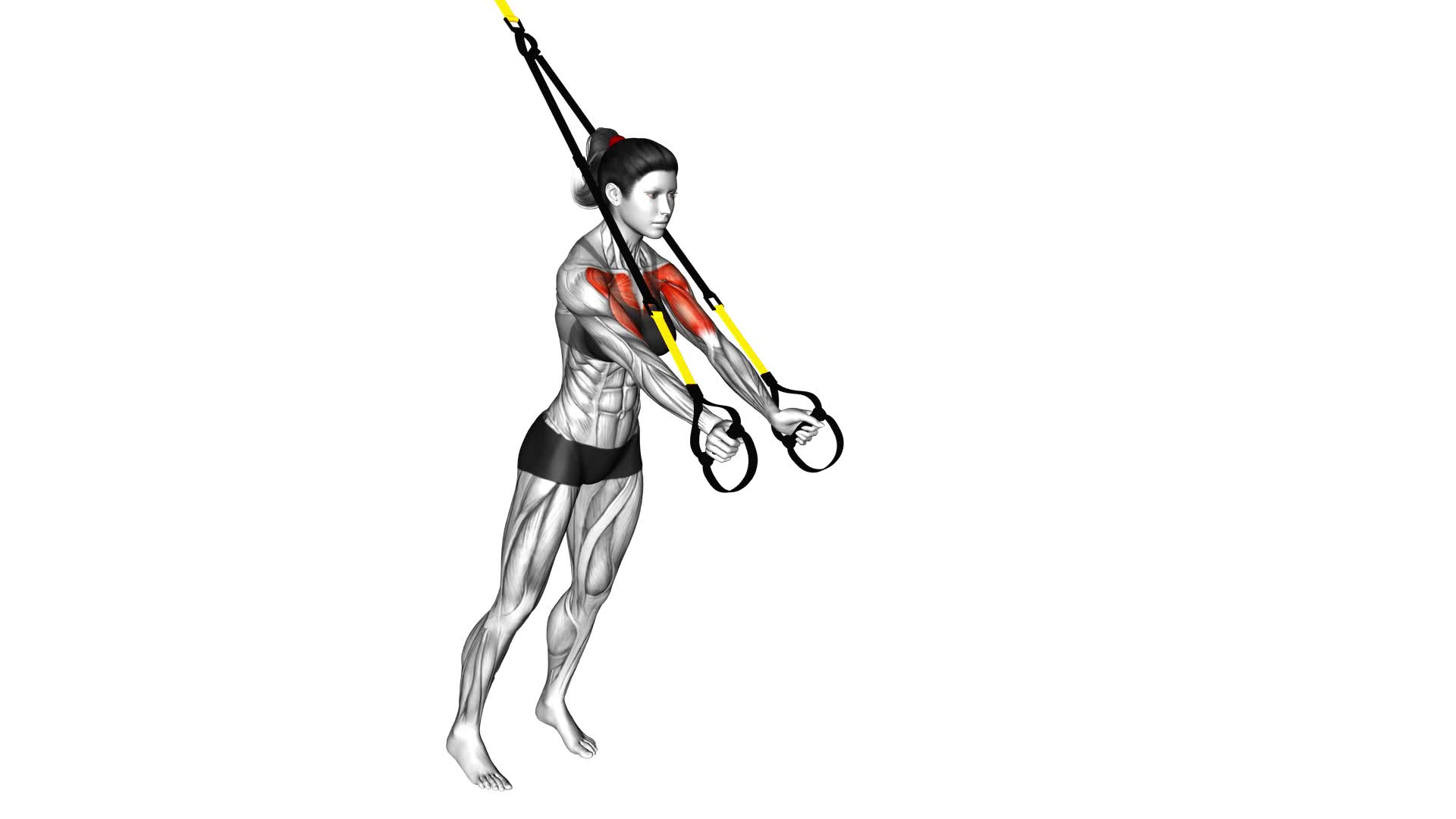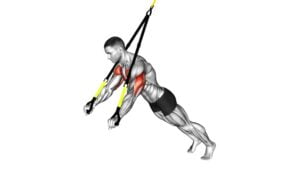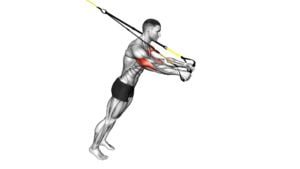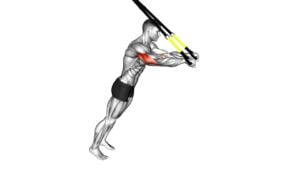Suspension Fly – Video Exercise Guide & Tips

Want to take your fitness routine to the next level? Look no further than the Suspension Fly. This dynamic exercise targets your upper body and core, helping you build strength and stability.
Watch This Exercise Video
In this article, we'll guide you through proper form and technique, offer variations and progressions, and share common mistakes to avoid.
Plus, we'll provide tips for getting the most out of your workout. Get ready to elevate your fitness game with the Suspension Fly!
Key Takeaways
- Suspension Fly improves upper body strength and stability.
- Suspension Fly targets the chest, shoulders, and arms, activating deltoids and triceps.
- Suspension Fly challenges core stability.
- Proper form and technique, including maintaining a stable stance, engaging the core, and avoiding common mistakes, are important for maximizing the benefits of Suspension Fly.
Benefits of Suspension Fly
The benefits of suspension fly include improved upper body strength and stability. When performing this exercise, you engage multiple muscles in your upper body, leading to increased muscle activation. The suspension straps require you to stabilize your body throughout the movement, which helps to improve core stability.
Suspension fly primarily targets the muscles in your chest, shoulders, and arms. As you extend your arms out to the sides, you activate the muscles in your chest, particularly the pectoralis major and minor. This movement also engages the deltoids in your shoulders, helping to strengthen and tone them. Additionally, your triceps are activated as you push the straps away from your body.
Furthermore, suspension fly challenges your core stability. The instability of the straps forces your core muscles, including your abdominals and lower back, to work harder to maintain balance and control. This not only strengthens your core but also improves your overall stability and posture.
Incorporating suspension fly into your workout routine can be a beneficial way to enhance upper body strength and stability. By engaging multiple muscle groups and challenging your core, this exercise helps you develop a strong and stable upper body.
Proper Form and Technique
To perform the suspension fly exercise with proper form and technique, start by positioning yourself in a stable stance. Place your feet shoulder-width apart and keep your knees slightly bent. This will ensure that you have a strong and balanced foundation throughout the exercise.
One common misconception about the suspension fly is that it primarily targets the chest muscles. While it does engage the chest, it also activates the shoulders, triceps, and core muscles. To maximize muscle activation, focus on maintaining a neutral spine and engaging your core throughout the movement. Keep your shoulders down and back, and avoid shrugging or hunching forward.
To perform the exercise, grab the suspension handles and extend your arms in front of you at shoulder height. From this starting position, slowly lower your body by allowing your arms to move out to the sides. Keep your elbows slightly bent and maintain control throughout the movement. Pause when your arms are parallel to the floor, and then squeeze your chest muscles to bring your body back to the starting position.
Variations and Progressions
To continue building upon your foundation and challenge your muscles further, you can explore different variations and progressions of the suspension fly exercise. These advanced variations can help you target specific muscles and take your workout to the next level.
Here are three variations you can try:
- Single Arm Suspension Fly: Instead of using both arms, perform the exercise with one arm at a time. This not only increases the challenge but also helps to isolate and strengthen each side of your upper body.
- Wide Grip Suspension Fly: Position your hands wider apart on the suspension trainer handles. This variation places more emphasis on your chest muscles, particularly the outer chest.
- Decline Suspension Fly: Elevate your feet on a bench or step to create a decline angle. This variation shifts the focus to your upper chest and shoulders, providing a different stimulus to these muscle groups.
Common Mistakes to Avoid
When incorporating variations and progressions of the suspension fly exercise, it's important to be mindful of common mistakes to avoid. Proper alignment and positioning are crucial for getting the most out of this exercise and preventing injury.
One common mistake to avoid is rounding your shoulders or arching your back. This can put unnecessary stress on your spine and limit the effectiveness of the exercise. Instead, focus on keeping your shoulders pulled back and down, and maintaining a neutral spine throughout the movement.
Another mistake to watch out for is using too much momentum. It's easy to swing your body or use a jerking motion to lift the straps, but this takes away from the targeted muscle engagement. To maximize the benefits, perform the exercise in a controlled manner, focusing on the contraction of your chest muscles.
Improper grip can also hinder your progress. Avoid gripping the handles too tightly, as this can cause unnecessary tension in your forearms and wrists. Instead, aim for a relaxed grip and focus on engaging your chest muscles.
Tips for Maximizing Your Workout
To maximize your workout, consistently focus on proper form and technique during the suspension fly exercise. This will help you target the intended muscles and reduce the risk of injury.
In addition to maintaining proper form, there are a few other tips that can help you get the most out of your workout:
- Pre-workout nutrition: Fueling your body with the right nutrients before your workout is essential for optimal performance. Aim to consume a balanced meal or snack that includes carbohydrates for energy, protein for muscle repair, and healthy fats for sustained energy.
- Post-workout recovery strategies: After your workout, it's important to prioritize recovery to promote muscle growth and reduce soreness. Make sure to properly cool down by stretching and foam rolling. Additionally, refuel your body with a combination of carbohydrates and protein within 30 minutes of finishing your workout to aid in muscle recovery.
- Listen to your body: Pay attention to how your body feels during and after your workout. If something doesn't feel right or if you experience pain, it's important to modify or stop the exercise. Pushing through pain can lead to further injury and setbacks in your fitness journey.
Frequently Asked Questions
How Long Should I Perform Suspension Fly Exercises for Optimal Results?
To achieve optimal results with suspension fly exercises, it's important to perform them for the right amount of time. The duration may vary depending on your fitness level and goals. Generally, aim for 3-4 sets of 8-12 reps, resting for 30-60 seconds between sets.
This allows you to work your muscles effectively without overexerting them. However, it's crucial to maintain proper form and avoid common mistakes in suspension fly variations to prevent injury and maximize results.
Can Suspension Fly Exercises Help Improve Posture?
Suspension fly exercises can indeed help improve your posture. By strengthening your core and overall strength, these exercises contribute to better posture.
The benefits of suspension fly exercises for overall strength include targeting multiple muscle groups simultaneously, leading to increased stability and balance.
Additionally, the engagement of your core muscles during these exercises improves core stability, which is crucial for maintaining good posture.
Incorporating suspension fly exercises into your workout routine can have a positive impact on your posture and overall fitness.
Is It Safe to Perform Suspension Fly Exercises if I Have a Shoulder Injury?
If you have a shoulder injury, it's important to be cautious when performing suspension fly exercises. These exercises can put strain on the shoulder joint and potentially worsen the injury.
It's best to consult with a healthcare professional for guidance on safe modifications or alternative shoulder exercises that can help you strengthen your upper body without risking further harm.
Safety should always be your top priority when exercising with an injury.
Can Suspension Fly Exercises Be Effective for Weight Loss?
Suspension fly exercises can be an effective alternative for weight loss. By engaging multiple muscles and challenging your stability, suspension training can help you burn calories and build lean muscle mass.
The instability of the straps forces your body to work harder, increasing your heart rate and boosting your metabolism.
Additionally, suspension training offers a variety of exercises that target different muscle groups, allowing you to create a well-rounded workout routine for weight loss.
Are There Any Specific Muscles Targeted by Suspension Fly Exercises?
When doing suspension fly exercises, you'll be targeting specific muscles in your body. These exercises can work your chest, shoulders, and triceps effectively. By adjusting the angle and position of your body, you can focus on different muscle groups and create variations of the suspension fly exercise.
It's a versatile workout that allows you to engage multiple muscles while building strength and stability. Keep reading to learn more about the muscles targeted and different variations of suspension fly exercises.
Conclusion
In conclusion, suspension fly is a highly effective exercise that offers numerous benefits, including improved upper body strength and stability. By maintaining proper form and technique, you can optimize the results and minimize the risk of injury.
Additionally, incorporating variations and progressions can help challenge your muscles and prevent plateauing. Avoiding common mistakes and following the tips provided will ensure you get the most out of your workout.
So, grab those suspension straps and start flying towards a stronger, fitter you!

Author
Years ago, the spark of my life’s passion ignited in my mind the moment I stepped into the local gym for the first time. The inaugural bead of perspiration, the initial endeavor, the very first surge of endorphins, and a sense of pride that washed over me post-workout marked the beginning of my deep-seated interest in strength sports, fitness, and sports nutrition. This very curiosity blossomed rapidly into a profound fascination, propelling me to earn a Master’s degree in Physical Education from the Academy of Physical Education in Krakow, followed by a Sports Manager diploma from the Jagiellonian University. My journey of growth led me to gain more specialized qualifications, such as being a certified personal trainer with a focus on sports dietetics, a lifeguard, and an instructor for wellness and corrective gymnastics. Theoretical knowledge paired seamlessly with practical experience, reinforcing my belief that the transformation of individuals under my guidance was also a reflection of my personal growth. This belief holds true even today. Each day, I strive to push the boundaries and explore new realms. These realms gently elevate me to greater heights. The unique combination of passion for my field and the continuous quest for growth fuels my drive to break new ground.



